Effect of Plasma Actuator Layout on the Passage Vortex Reduction in a Linear Turbine Cascade for a Wide Range of Reynolds Numbers
Abstract
:1. Introduction
2. Experimental Method
2.1. Linear Turbine Cascade (LTC)
2.2. Particle Image Velocimetry (PIV) Measurements
2.3. Plasma Actuator (PA)
3. Experimental Results and Discussion
3.1. Effect of Actuator Layout at Reout = 3.7 × 104
3.1.1. Velocity Distribution of the Secondary Flow at PA1 (Axial PA)
3.1.2. Velocity Distribution of the Secondary Flow at PA2 (Slanted PA Blade Inlet)
3.1.3. Velocity Distribution of the Secondary Flow at PA3 (Slanted PA Blade Inside)
3.1.4. Quantitative Comparison between the Velocity Distributions of Three PA Layouts
3.1.5. Streamlines and Center Position of the Passage Vortex
3.1.6. Turbulence Intensity Distribution
3.1.7. Vorticity Distribution
3.1.8. Discussion: Comparison with Previous Compressor Blade Studies
3.2. Influence of Reynolds Number
3.2.1. Flow Field at the Lowest Reynolds Number Reout = 1.0 × 104
3.2.2. Flow Field at the Highest Reynolds Number Reout = 9.9 × 104
3.2.3. Change in Peak Vorticity
4. Conclusions
- In suppressing the PV of the turbine blade, the slanted layouts (PA2 and PA3) tended to be more effective than the axial layout (PA1). This conclusion contradicts the findings of a prior study focused on enhancing the surge margin of compressor blades (suppression of the blade tip leakage vortex), in which the axial layout of the PA was more effective than the slanted layout. This difference is thought to be due to two factors: (1) the blade shape is very different between the turbine and compressor blades, and (2) the control target is different from the PV and blade tip leakage vortex.
- A comparison between PA2 and PA3 at Reout = 3.7 × 104 shows that PA2 is more effective than PA3 in suppressing the area-averaged velocity of the secondary flow and suppressing the negative peak vorticity value.
- When PA3 was driven at a high input voltage, additional vortices were generated at the blade exit, corner of the blade PS side, and upper endwall. This is thought to be due to the excessive effect of the PA-induced flow on the boundary layer on the slow-blade PS side because a part of the PA enters the blades in the PA3 layout.
- The effect of the PA layout differs depending on the Reynolds number. In the low-Re region, the impact of reducing the negative vorticity peak values in the PA2 and PA3 layouts is similar. By contrast, in the high-Re region, the effect of reducing the peak vorticity in the PA2 layout is remarkable.
- Even at the highest Reynolds number Reout = 9.9 × 104 (mainstream velocity at the blade exit: 25.4 m/s), the peak negative vorticity due to the PV decreases by 20.2%.
Author Contributions
Funding
Data Availability Statement
Conflicts of Interest
Nomenclature
| Latin symbols | |
| Re | Reynolds number |
| Tu | Turbulence intensity (%) |
| U | Velocity (m/s) |
| VAC | Peak-to-peak input voltage (kV) |
| X | Horizontal direction (mm) |
| Y | Span-wise (vertical) direction (mm) |
| Greek symbols | |
| Ω | Vorticity (1/s) |
| Abbreviations | |
| DBD | Dielectric barrier discharge |
| PA | Plasma actuator |
| PS | Pressure surface |
| PV | Passage vortex |
| SS | Suction surface |
References
- Sieverding, C.H. Recent progress in the understanding of basic aspects of secondary flows in turbine blade passages. ASME J. Eng. Gas Turbines Power 1985, 107, 248–257. [Google Scholar] [CrossRef]
- Denton, J.D. The 1993 IGTI Scholar Lecture: Loss mechanisms in turbomachines. ASME J. Turbomach. 1993, 115, 621–656. [Google Scholar] [CrossRef]
- Matsunuma, T.; Abe, H.; Tsutsui, Y. Influence of Turbulence Intensity on Annular Turbine Stator Aerodynamics at Low Reynolds Numbers. In Proceedings of the ASME 1999 International Gas Turbine and Aeroengine Congress and Exhibition, Indianapolis, IN, USA, 7–10 June 1999. ASME Paper No. 99-GT-151. [Google Scholar] [CrossRef]
- Ananthakrishnan, K.; Govardhan, M. Influence of fillet shapes on secondary flow field in a transonic axial flow turbine stage. Aerosp. Sci. Technol. 2018, 82–83, 425–437. [Google Scholar] [CrossRef]
- Chung, J.T.; Simon, T.W.; Buddhavarapu, J. Three-dimensional flow near the blade/endwall junction of a gas turbine: Application of a boundary layer fence. In Proceedings of the ASME Turbo Expo 1991, Orland, FL, USA, 3–6 June 1991. ASME Paper No. 91-GT-045. [Google Scholar] [CrossRef]
- Kumar, K.N.; Govardha, M. Secondary Flow Loss Reduction in a Turbine Cascade with a Linearly Varied Height Streamwise Endwall Fence. Int. J. Rotating Mach. 2011, 2011, 352819. [Google Scholar] [CrossRef]
- Yuan, H.; Wu, Y.; Zhou, S.; Wang, M.; Lu, X.; Zhang, Y. Nonuniform height endwall fence optimization of a low-pressure turbine cascade. Int. J. Mech. Sci. 2023, 250, 108301. [Google Scholar] [CrossRef]
- Miao, X.; Zhang, Q.; Jiang, H.; Qi, H. Application of Riblets on Turbine Blade Endwall Secondary Flow Control. In Proceedings of the ASME Turbo Expo 2014: Turbine Technical Conference and Exposition, Düsseldorf, Germany, 16–20 June 2014. ASME Paper No. GT2014-26823. [Google Scholar] [CrossRef]
- Schmid, J.; Schulz, A.; Bauer, H.J. Influence of a non-axisymmetric endwall on the flow field in a turbine passage: High resolution LDV. In Proceedings of the ASME Turbo Expo 2018: Turbomachinery Technical Conference and Exposition, Oslo, Norway, 11–15 June 2018. ASME Paper No. GT2018-75061. [Google Scholar] [CrossRef]
- Zhang, K.; Li, Z.; Li, J. Non-axisymmetric endwall contour optimization and performance assessment as affected by simulated swirl purge flow and backward hole injection. Int. J. Therm. Sci. 2022, 172, 107297. [Google Scholar] [CrossRef]
- Shyam, V.; Ameri, A.; Poinsatte, P.; Thurman, D.; Wroblewski, A.; Snyder, C. Application of pinniped vibrissae to aeropropulsion. In Proceedings of the ASME Turbo Expo 2015, Montréal, QC, Canada, 15–19 June 2015. ASME Paper No. GT2015-43055. [Google Scholar] [CrossRef]
- Benton, S.I.; Bons, J.P.; Sondergaard, R. Secondary flow loss reduction through blowing for a high-lift front-loaded low pressure turbine cascade. ASME J. Turbomach. 2013, 135, 021020. [Google Scholar] [CrossRef]
- Benton, S.I.; Bernardini, C.; Bons, J.P.; Sondergaard, R. Parametric optimization of unsteady end wall blowing on a highly loaded low-pressure turbine. ASME J. Turbomach. 2014, 136, 071013. [Google Scholar] [CrossRef]
- Bloxham, M.J.; Bons, J.P. A global approach to turbomachinery flow control: Passage vortex control. ASME J. Turbomach. 2014, 136, 041003. [Google Scholar] [CrossRef]
- Matsunuma, T. Effects of the Installation Location of a Dielectric Barrier Discharge Plasma Actuator on the Active Passage Vortex Control of a Turbine Cascade at Low Reynolds Numbers. Actuators 2022, 11, 129. [Google Scholar] [CrossRef]
- Matsunuma, T.; Segawa, T. Active Flow Control for Passage Vortex Reduction in a Linear Turbine Cascade with Various Tip Clearance Sizes Using a Dielectric Barrier Discharge Plasma Actuator. Aerospace 2023, 10, 641. [Google Scholar] [CrossRef]
- Corke, T.C.; Enloe, C.L.; Wilkinson, S.P. Dielectric Barrier Discharge Plasma Actuators for Flow Control. Annu. Rev. Fluid Mech. 2010, 42, 505–529. [Google Scholar] [CrossRef]
- Abe, Y.; Nonomura, T.; Sato, M.; Aono, H.; Fujii, K. Comparison of Separation Control Mechanisms for Synthetic Jet and Plasma Actuators. Actuators 2023, 12, 322. [Google Scholar] [CrossRef]
- Rodrigues, F.; Abdollahzadehsangroudi, M.; Nunes-Pereira, J.; Páscoa, J. Recent Developments on Dielectric Barrier Discharge (DBD) Plasma Actuators for Icing Mitigation. Actuators 2023, 12, 5. [Google Scholar] [CrossRef]
- Sekimoto, S.; Fujii, K.; Anyoji, M.; Miyakawa, Y.; Ito, S.; Shimomura, S.; Nishida, H.; Nonomura, T.; Matsuno, T. Flow Control around NACA0015 Airfoil Using a Dielectric Barrier Discharge Plasma Actuator over a Wide Range of the Reynolds Number. Actuators 2023, 12, 43. [Google Scholar] [CrossRef]
- Moreira, M.; Rodrigues, F.; Cândido, S.; Santos, G.; Páscoa, J. Development of a Background-Oriented Schlieren (BOS) System for Thermal Characterization of Flow Induced by Plasma Actuators. Energies 2023, 16, 540. [Google Scholar] [CrossRef]
- Emori, K.; Kaneko, Y.; Nishida, H. Comparison between Density and Velocity Fields in Burst Modulation of a Dielectric-Barrier-Discharge Plasma Actuator. Actuators 2022, 11, 340. [Google Scholar] [CrossRef]
- Abdullaev, A.; Kotvitskii, A.; Moralev, I.; Ustinov, M. On the Possibility of Cross-Flow Vortex Cancellation by Plasma Actuators. Aerospace 2023, 10, 469. [Google Scholar] [CrossRef]
- Vishnyakov, O.; Polivanov, P.; Sidorenko, A. Response of the Shock Wave/Boundary Layer Interaction to Disturbances Induced by the Plasma Discharge. Aerospace 2023, 10, 798. [Google Scholar] [CrossRef]
- Chernyshev, S.; Gadzhimagomedov, G.; Kuryachiy, A.; Sboev, D.; Tolkachev, S. 3D Turbulent Boundary Layer Separation Control by Multi-Discharge Plasma Actuator. Aerospace 2023, 10, 869. [Google Scholar] [CrossRef]
- Kazanskii, P.N. Closed-Loop Cavity Shear Layer Control Using Plasma Dielectric Barrier Discharge Actuators. Aerospace 2023, 10, 888. [Google Scholar] [CrossRef]
- Huang, J.; Corke, T.; Thomas, F. Plasma Actuators for Separation Control of Low Pressure Turbine Blades. In Proceedings of the 41st Aerospace Sciences Meeting and Exhibit, Reno, NV, USA, 6–9 January 2003. AIAA Paper, No. 2003-1027. [Google Scholar] [CrossRef]
- List, J.; Byerley, A.; McLaughlin, T.; Van Dyken, R. Using a plasma actuator to control laminar separation on a linear cascade turbine blade. In Proceedings of the 41st Aerospace Sciences Meeting and Exhibit, Reno, NV, USA, 6–9 January 2003. AIAA Paper, No. 2003-1026. [Google Scholar] [CrossRef]
- Pescini, E.; De Giorgi, M.; Suma, A.; Francioso, L.; Ficarella, A. Separation control by a microfabricated SDBD plasma actuator for small engine turbine applications: Influence of the excitation waveform. Aerosp. Sci. Technol. 2018, 76, 442–454. [Google Scholar] [CrossRef]
- Van Ness, D.K., II; Corke, T.C.; Morris, S.C. Turbine Tip Clearance Flow Control Using Plasma Actuators. In Proceedings of the 44th AIAA Aerospace Sciences Meeting and Exhibit, Reno, NV, USA, 9–12 January 2006. Paper No. AIAA 2006-21. [Google Scholar] [CrossRef]
- Yu, J.; Wang, Z.; Chen, F.; Yu, J.; Wang, C. Kriging surrogate model applied in the mechanism study of tip leakage flow control in turbine cascade by multiple DBD plasma actuators. Aerosp. Sci. Technol. 2019, 85, 216–228. [Google Scholar] [CrossRef]
- Matsunuma, T.; Segawa, T. Vortex structure for reducing tip leakage flow of linear turbine cascade using dielectric barrier discharge plasma actuator. Aerosp. Sci. Technol. 2023, 136, 108215. [Google Scholar] [CrossRef]
- Saddoughi, S.; Bennett, G.; Boespflug, M.; Puterbaugh, S.L.; Wadia, A.R. Experimental Investigation of Tip Clearance Flow in a Transonic Compressor With and Without Plasma Actuators. ASME J. Turbomach. 2015, 137, 041008. [Google Scholar] [CrossRef]
- Zhang, H.; Wu, Y.; Yu, X.; Li, Y.; Liu, B. Experimental Investigation on the Plasma Flow Control of Axial Compressor Rotating Stall. In Proceedings of the ASME Turbo Expo 2019: Turbomachinery Technical Conference and Exposition, Phoenix, AZ, USA, 17–21 June 2019. ASME Paper No. GT2019-90609. [Google Scholar] [CrossRef]
- Zhang, H.; Wu, Y.; Li, Y.; Yu, X.; Liu, B. Control of compressor tip leakage flow using plasma actuation. Aerosp. Sci. Technol. 2019, 86, 244–255. [Google Scholar] [CrossRef]
- Matsunuma, T. Unsteady flow field of an axial-flow turbine rotor at a low Reynolds number. ASME J. Turbomach. 2007, 129, 360–371. [Google Scholar] [CrossRef]
- Ashpis, D.E.; Thurman, D.R. DBD Plasma Actuators for Flow Control in Air Vehicles and Jet Engines—Simulation of Flight Conditions in Test Chambers by Density Matching. In Proceedings of the 42nd AIAA Plasmadynamics and Lasers Conference, Honolulu, Hawaii, 27−30 June 2011. Paper No. AIAA 2011-3730. [Google Scholar] [CrossRef]
- Benard, N.; Balcon, N.; Moreau, E. Electric wind produced by a surface dielectric barrier discharge operating in air at different pressures: Aeronautical control insights. J. Phys. D Appl. Phys. 2008, 41, 042002. [Google Scholar] [CrossRef]
- Valerioti, J.A.; Corke, T.C. Pressure Dependence of Dielectric Barrier Discharge Plasma Flow Actuators. AIAA J. 2012, 50, 1490–1502. [Google Scholar] [CrossRef]
- Raffel, M.; Willert, C.E.; Scarano, F.; Kähler, C.J.; Wereley, S.T.; Kompenhans, J. Particle Image Velocimetry: A Practical Guide, 3rd ed.; Springer: Berlin, Germany, 2018; Available online: https://link.springer.com/book/10.1007/978-3-319-68852-7 (accessed on 15 October 2023).
- Michelis, T.; Kotsonis, M. Flow control on a transport truck side mirror using plasma actuators. ASME J. Fluids Eng. 2015, 137, 111103. [Google Scholar] [CrossRef]
- Shima, Y.; Imai, R.; Ishikawa, H.; Segawa, T. Mechanism of Thrust–Power Ratio Improvement Using Plasma Actuator with Discretized Encapsulated Electrodes. Actuators 2022, 11, 296. [Google Scholar] [CrossRef]
- Matsunuma, T.; Segawa, T. Effects of Input Voltage and Freestream Velocity on Active Flow Control of Passage Vortex in a Linear Turbine Cascade Using Dielectric Barrier Discharge Plasma Actuator. Energies 2020, 13, 764. [Google Scholar] [CrossRef]

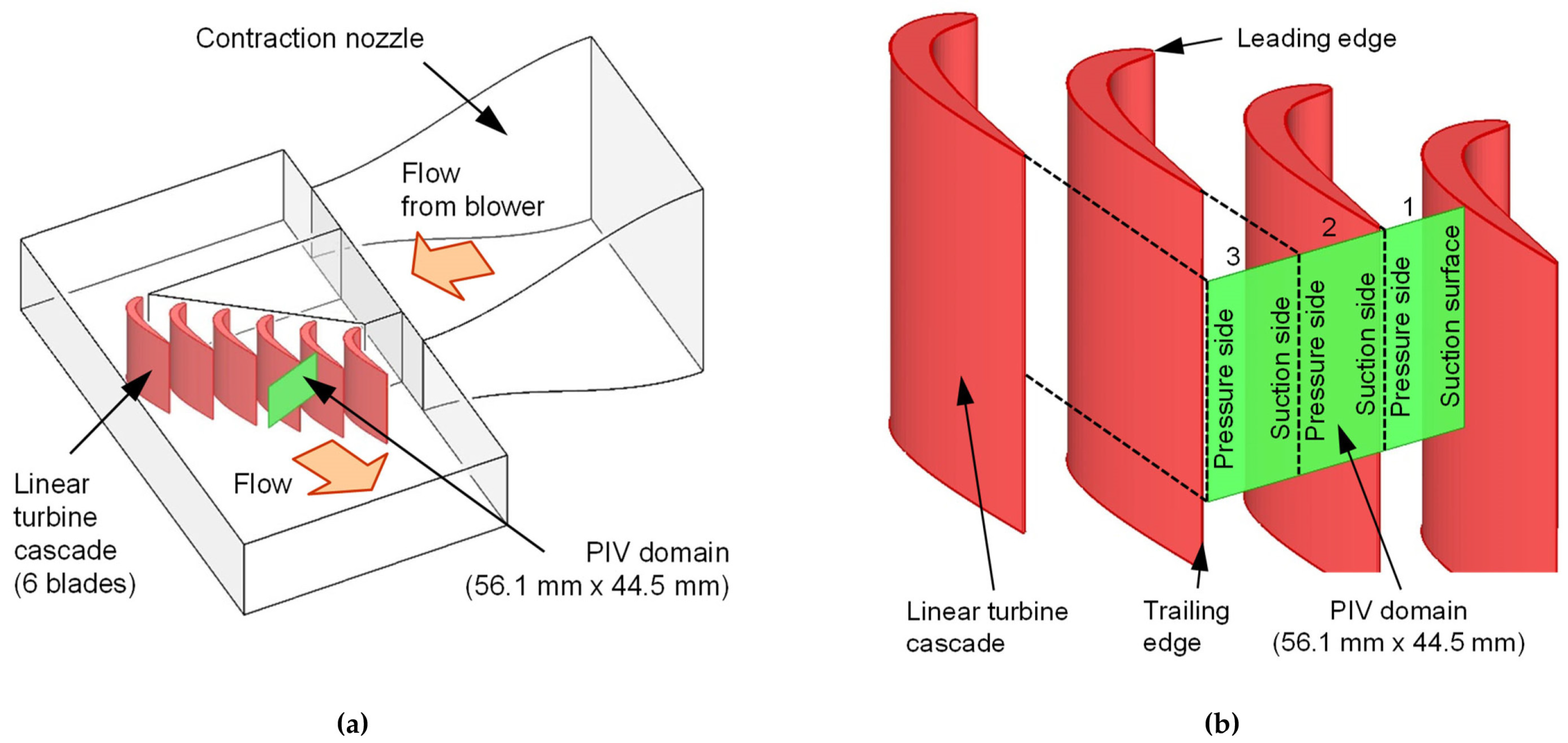
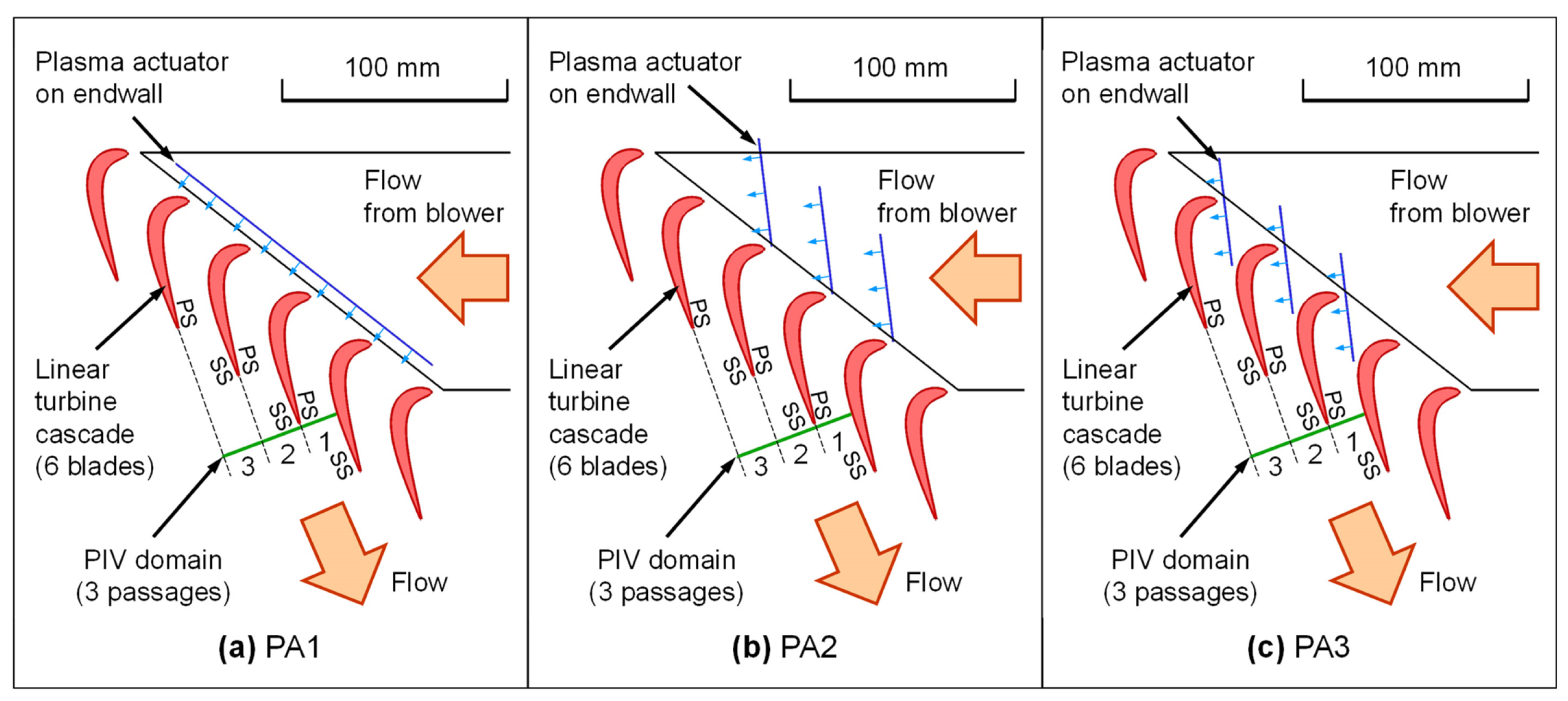
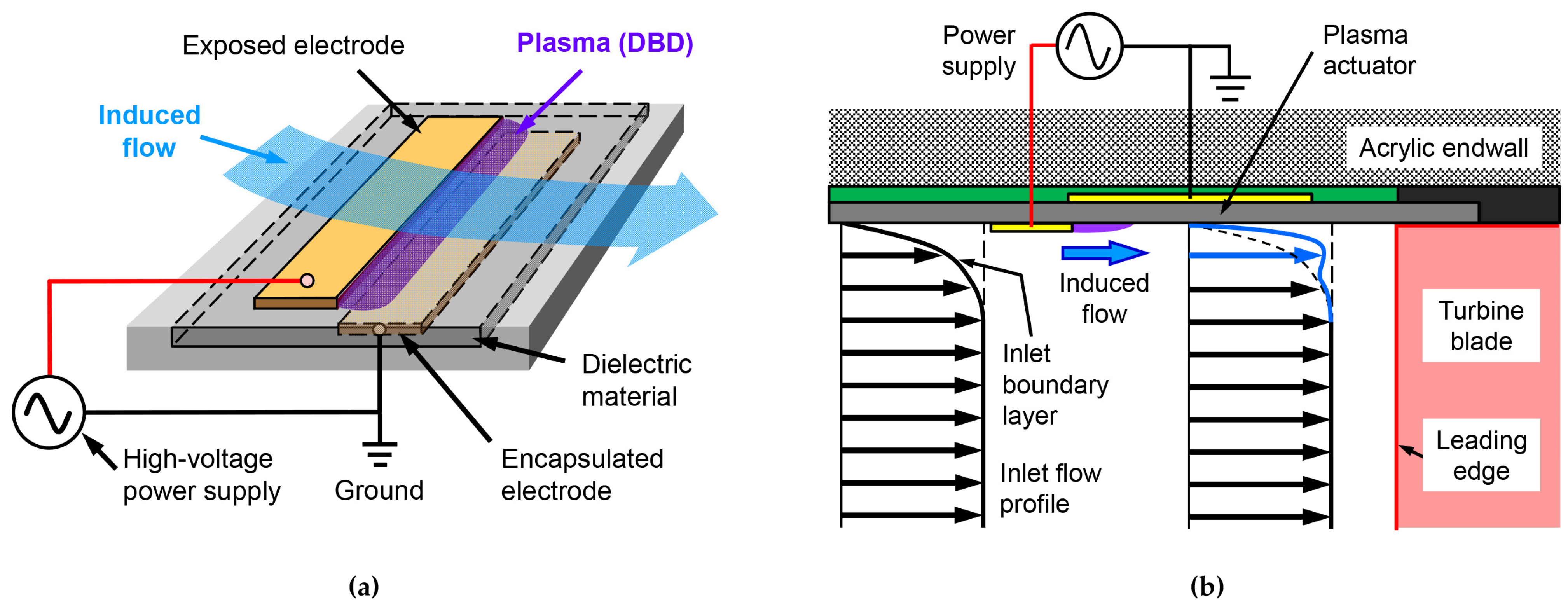
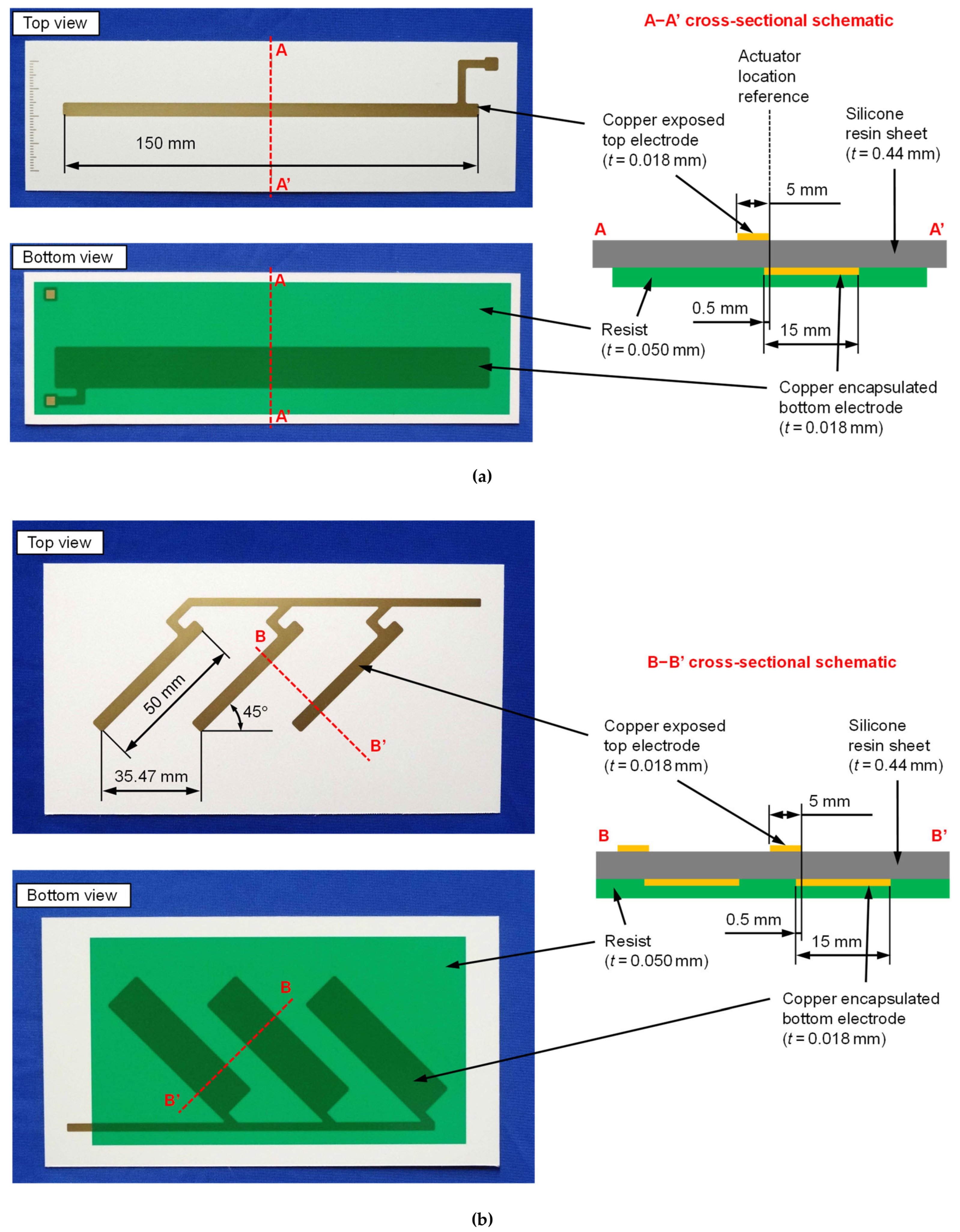


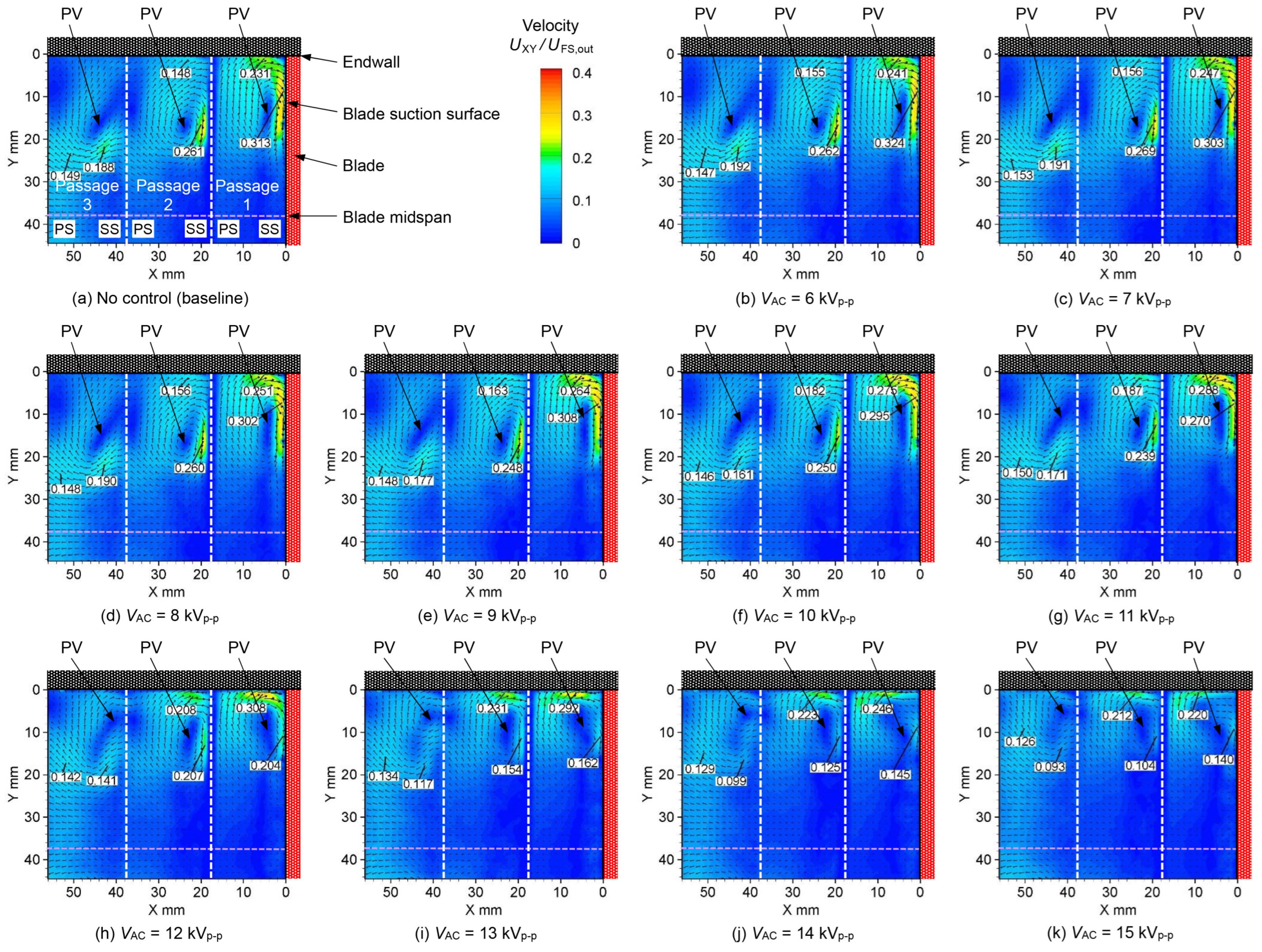
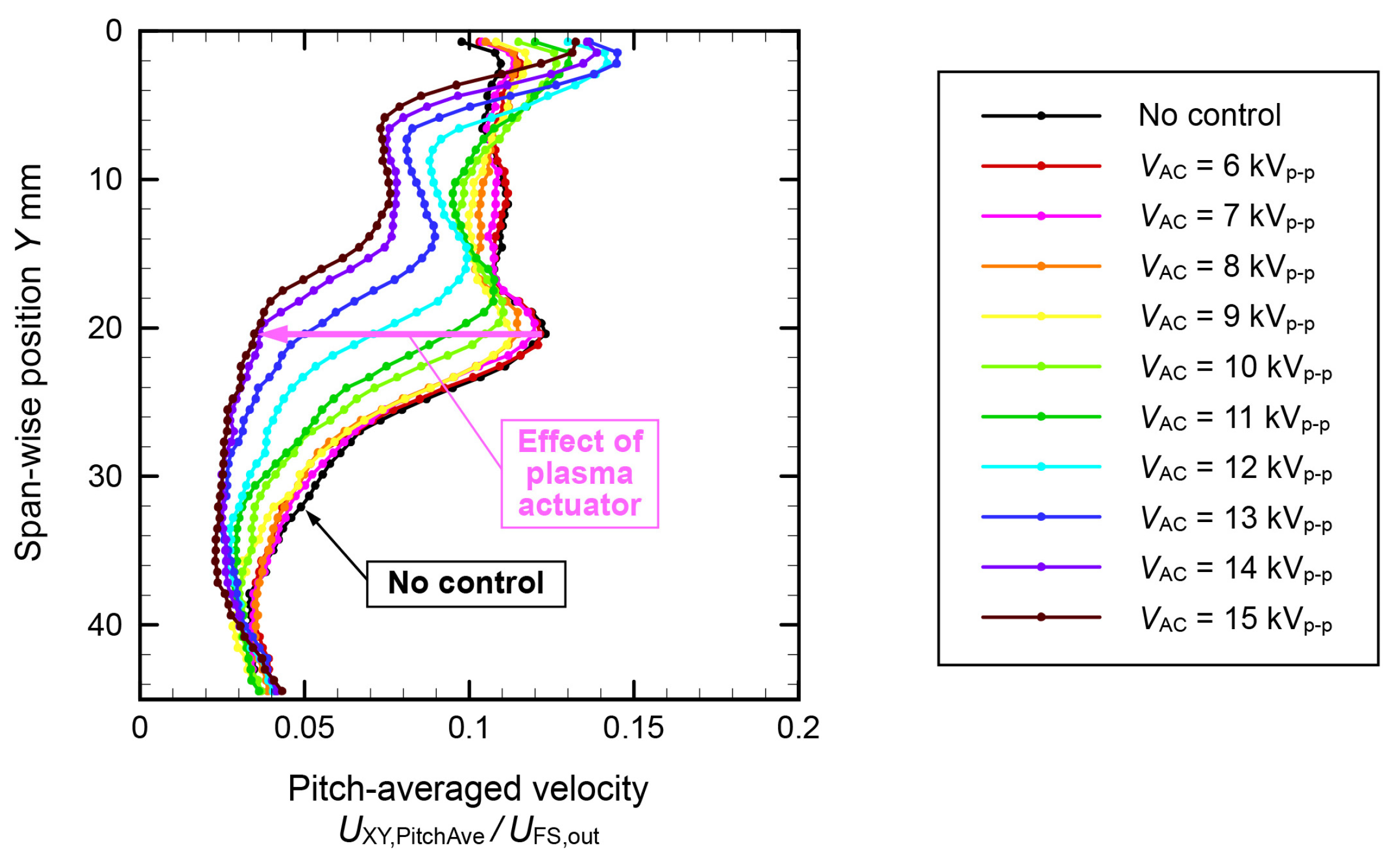

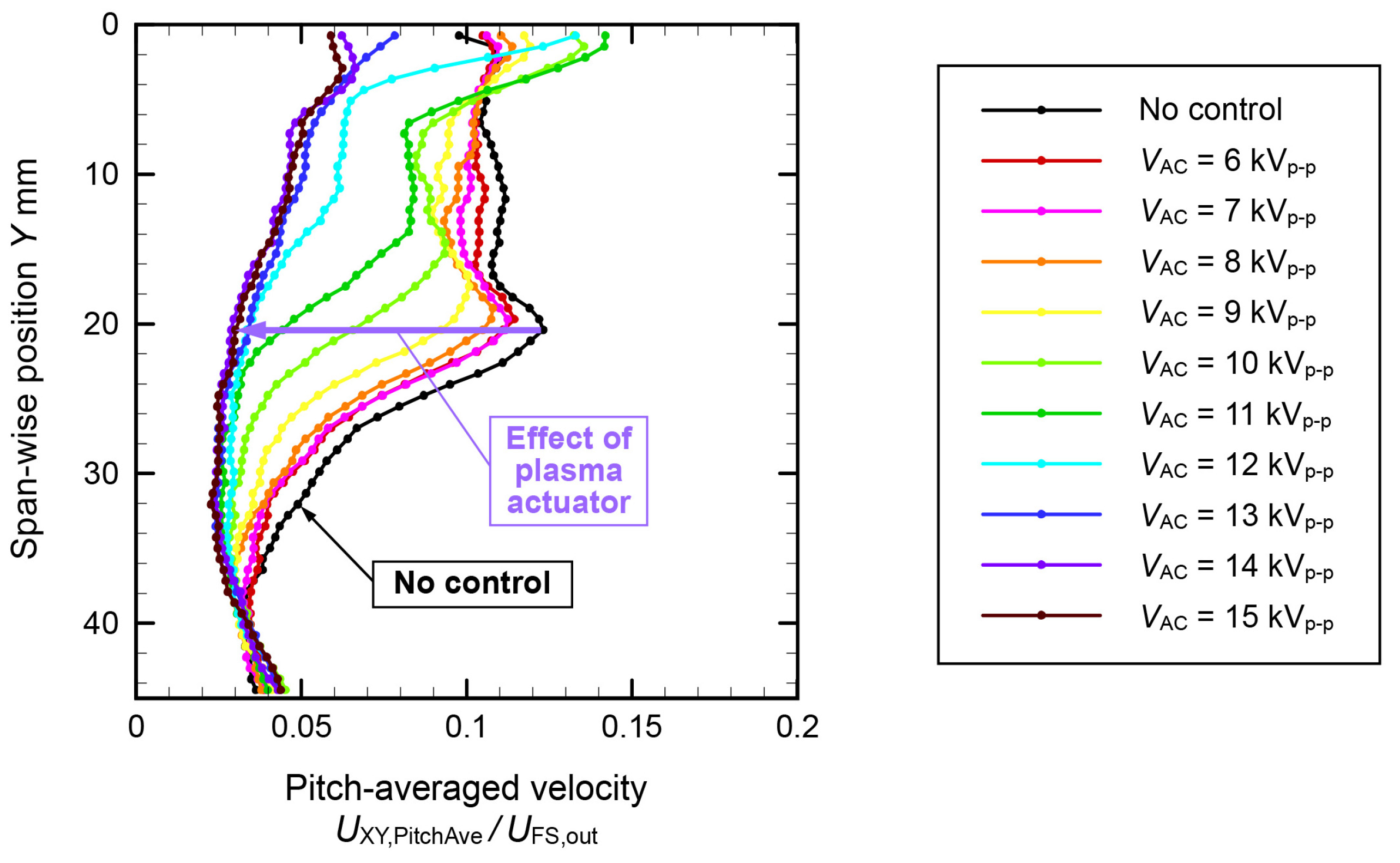

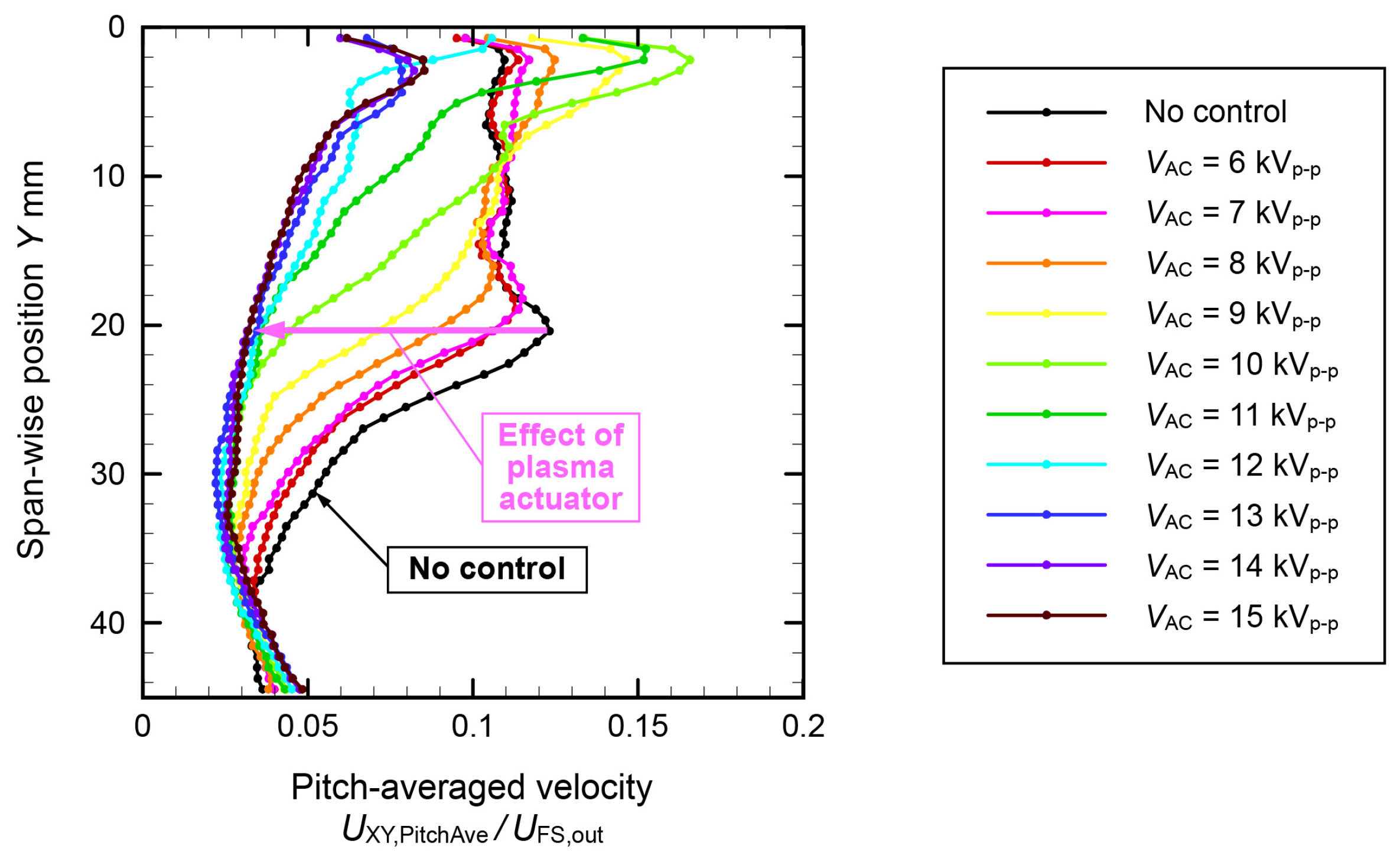
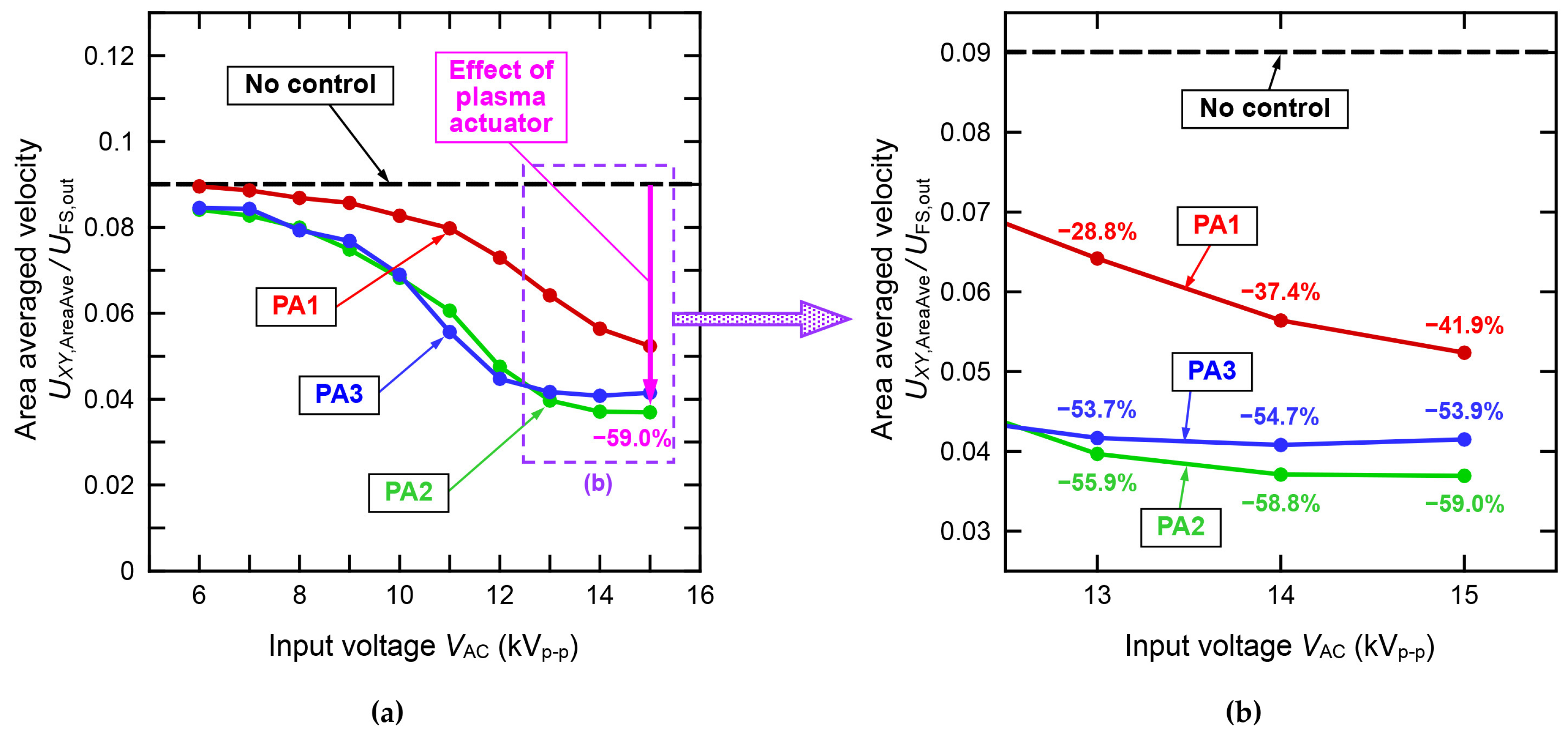

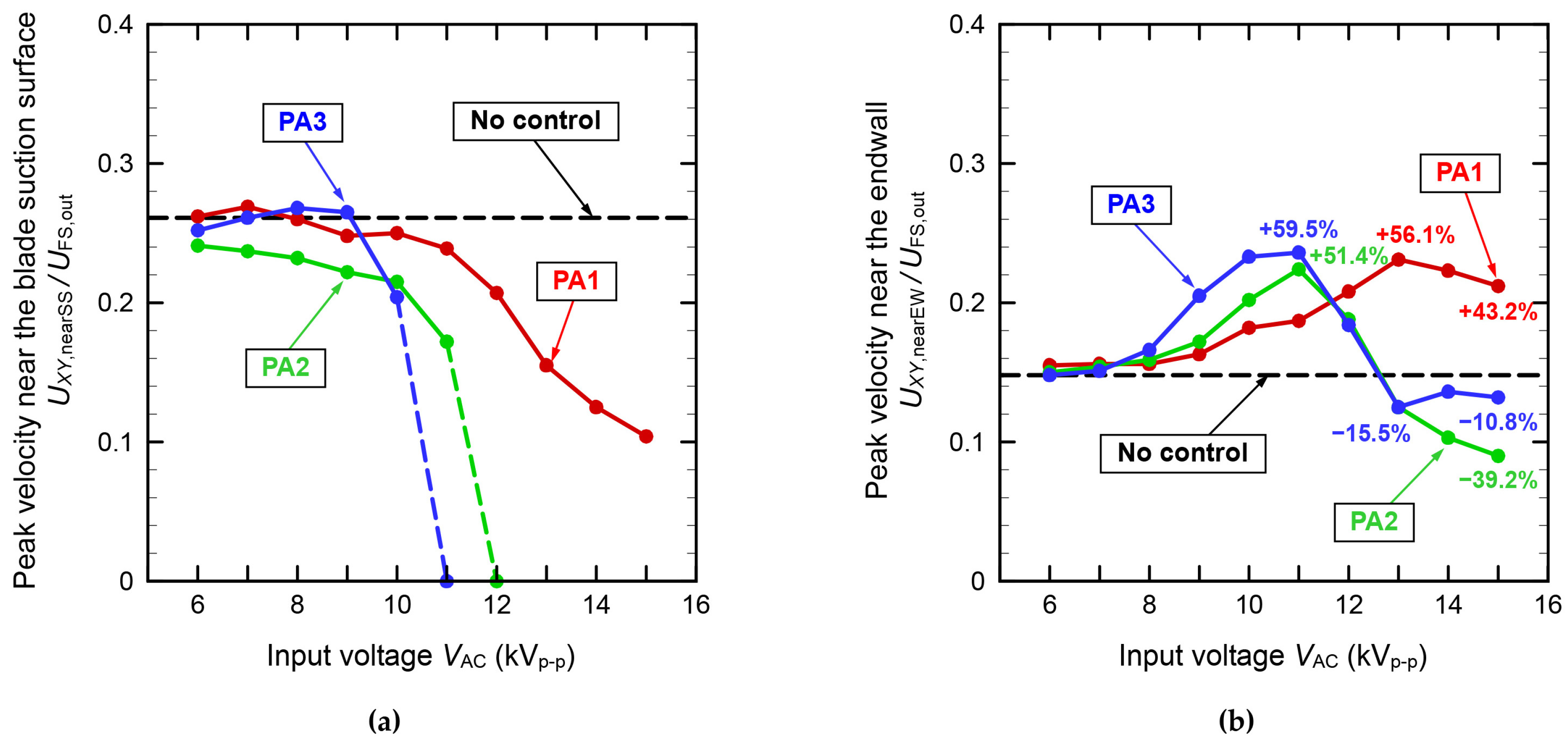
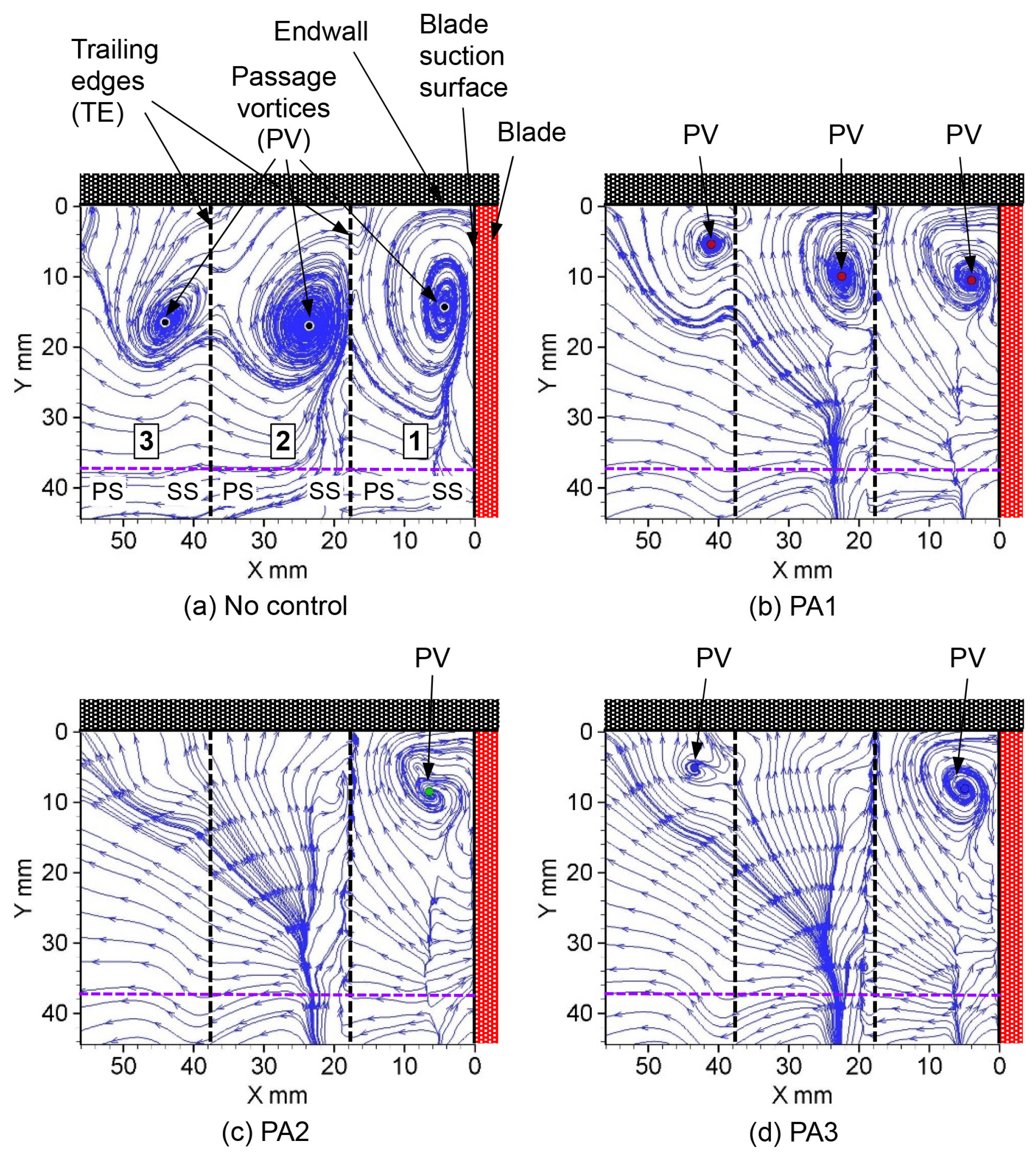
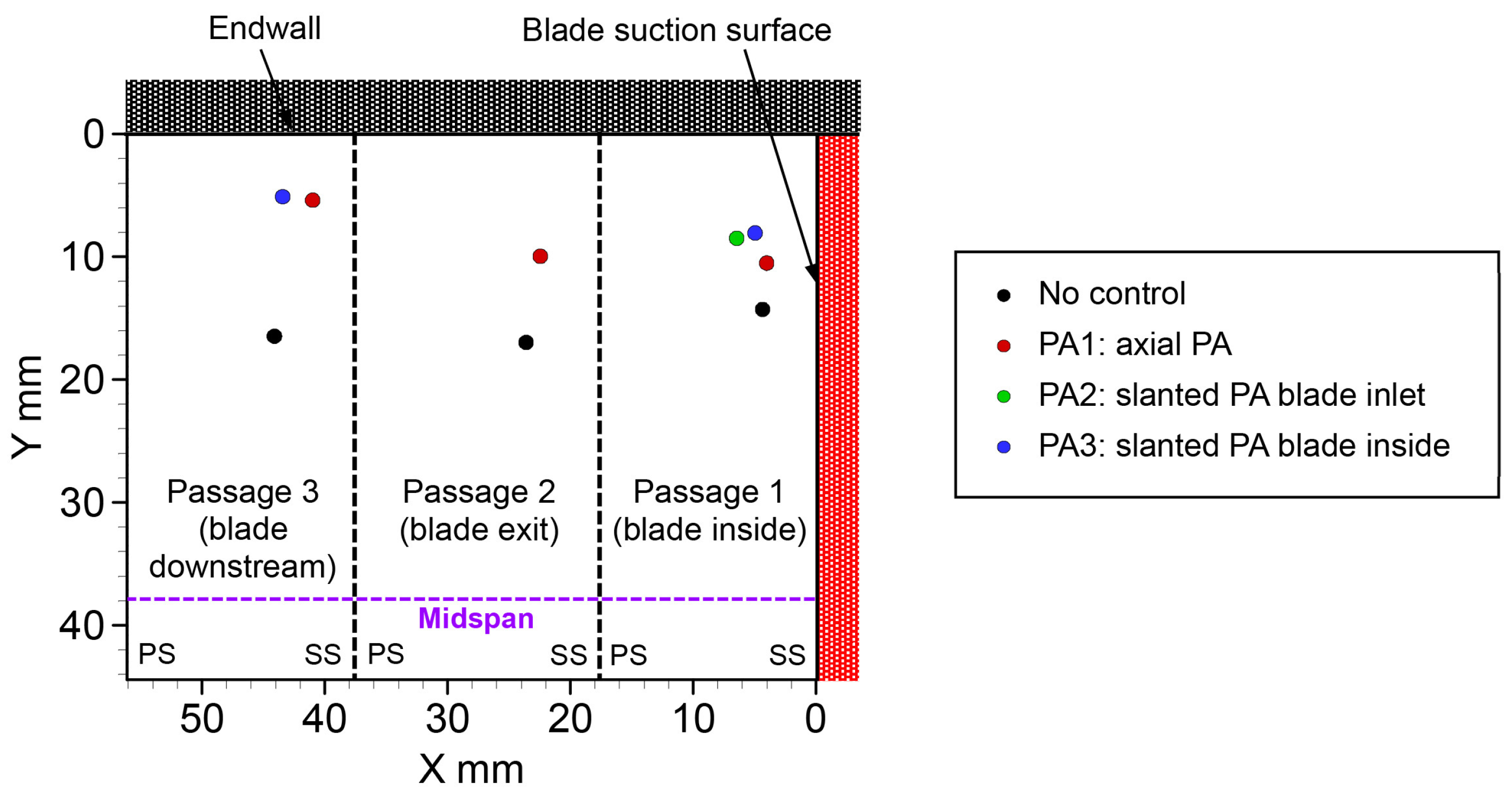
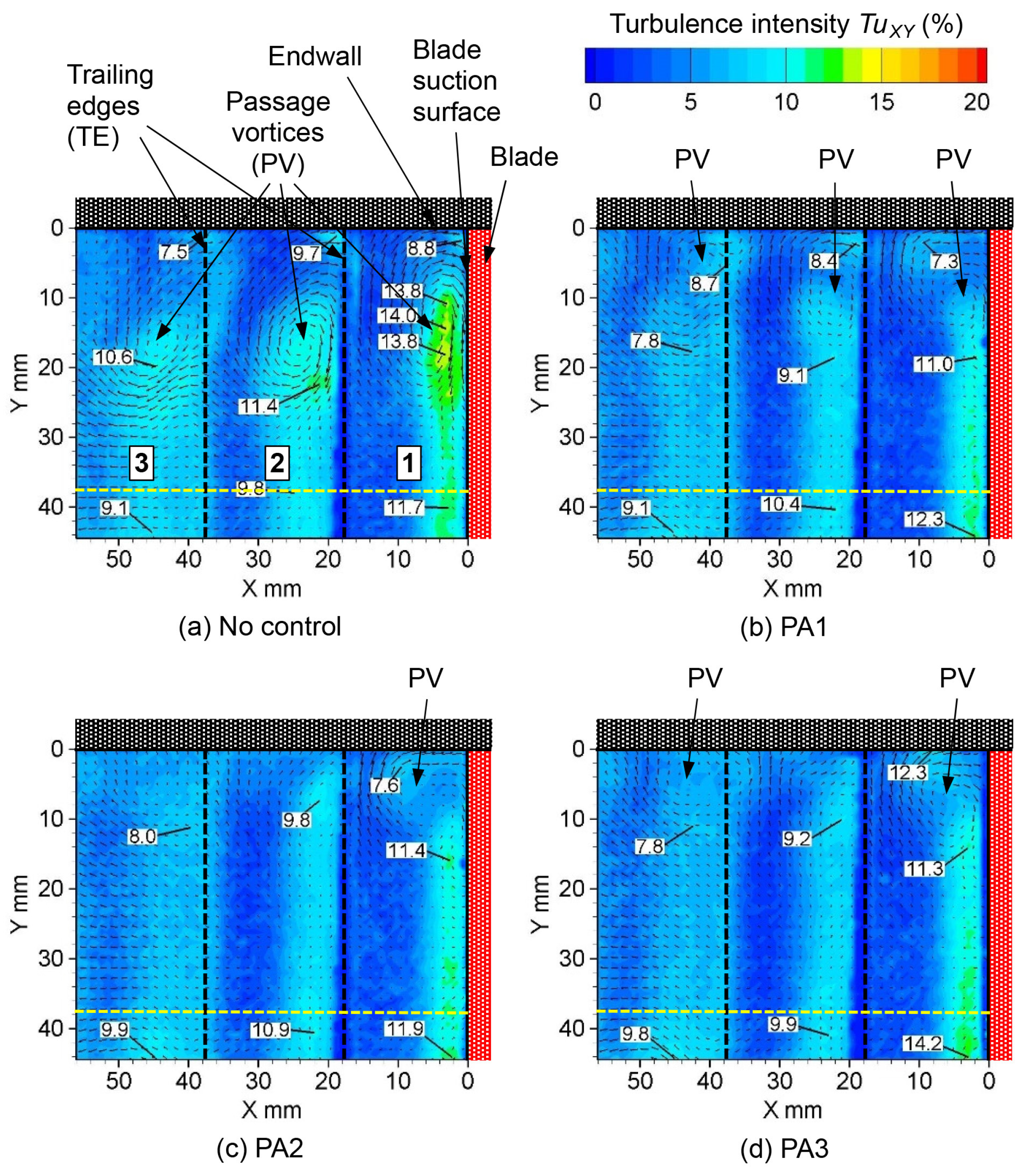

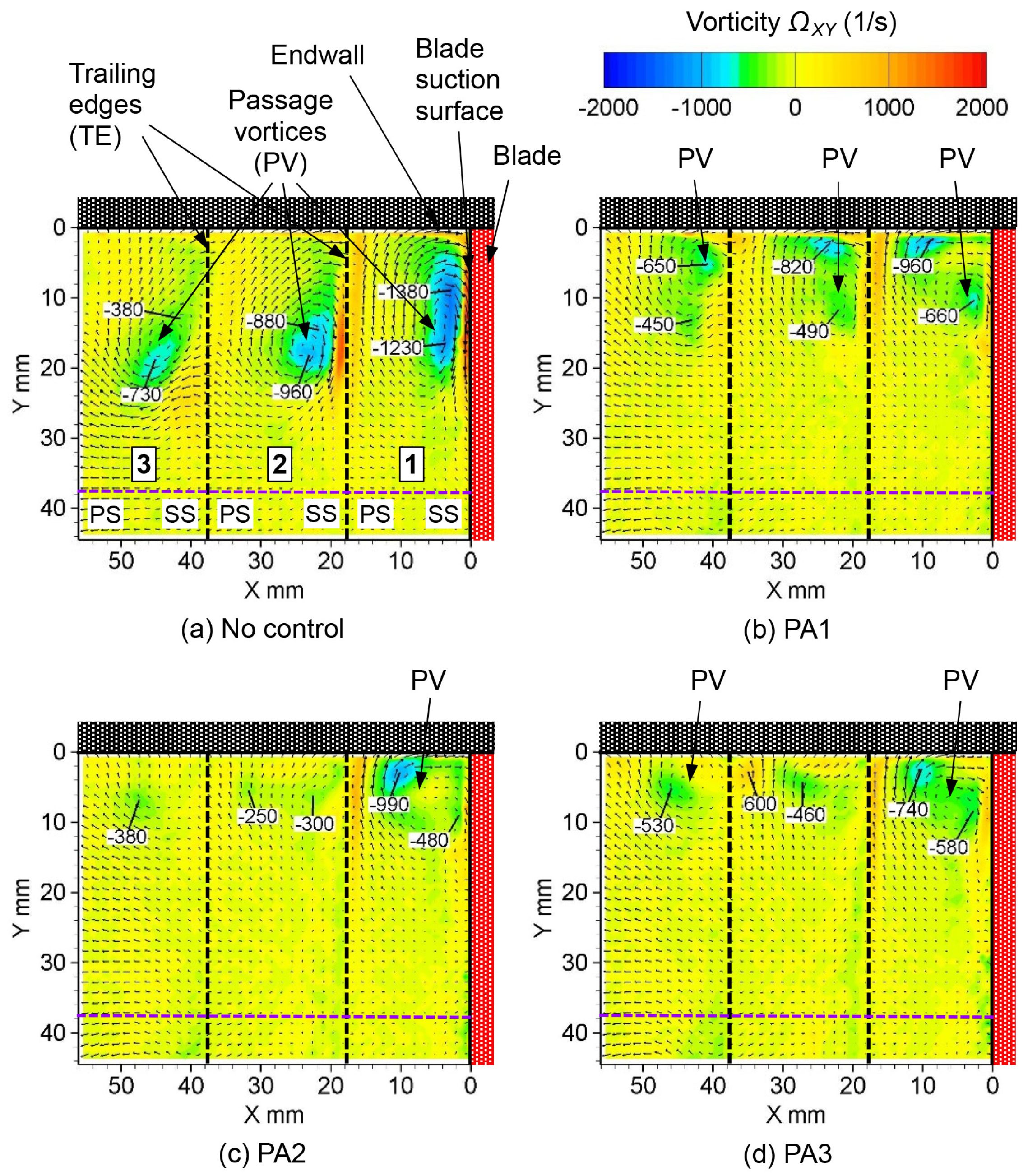
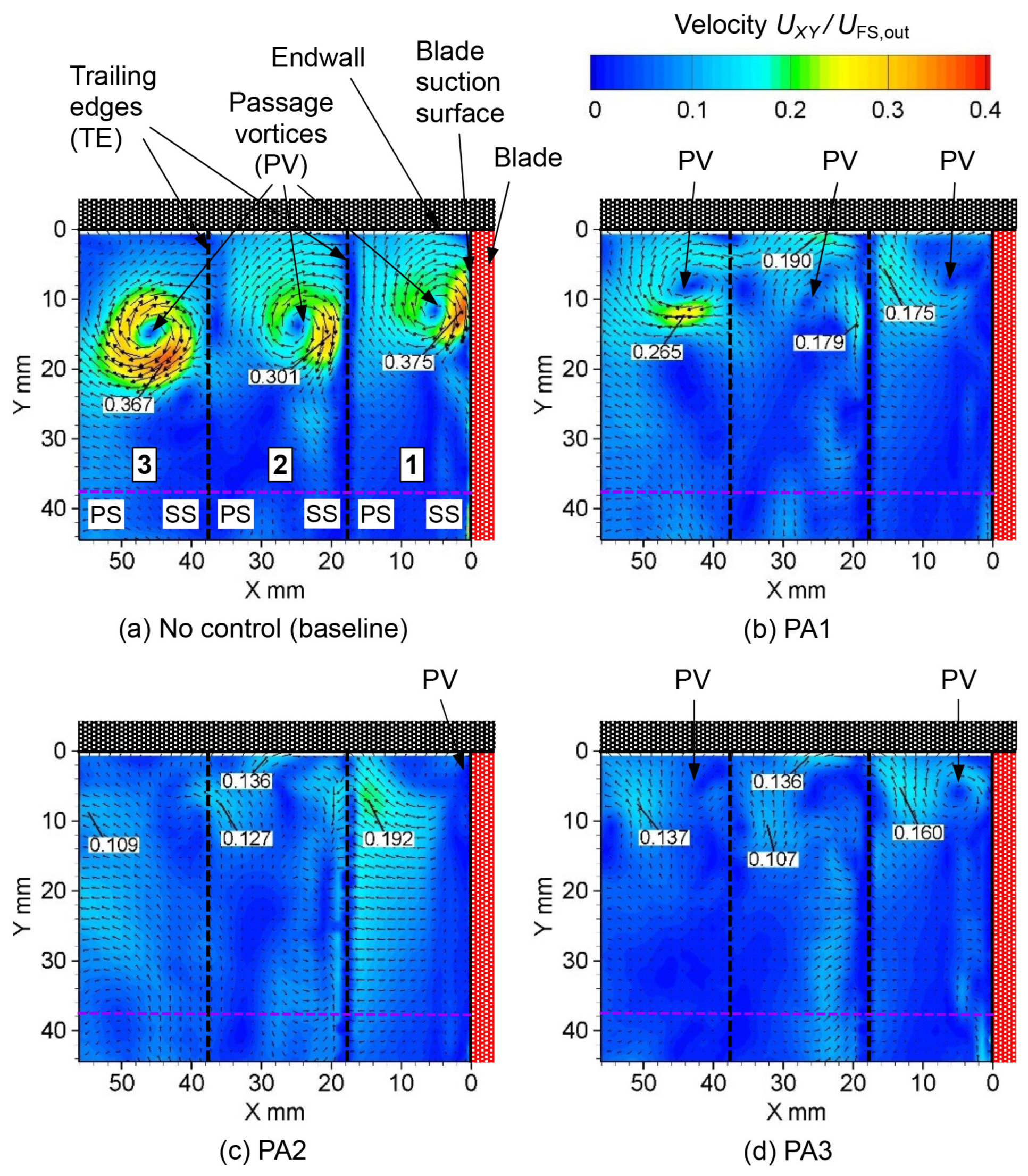
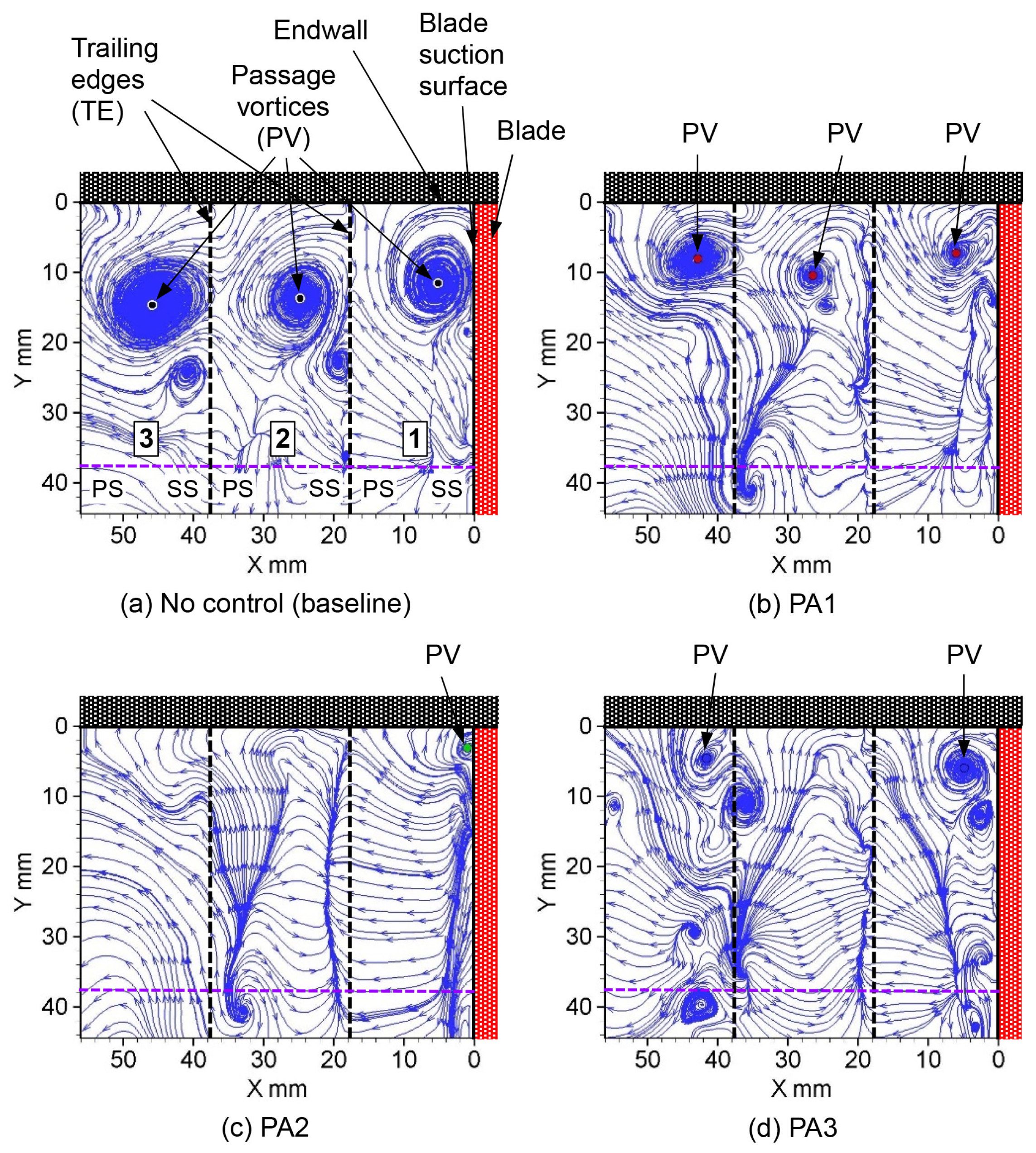
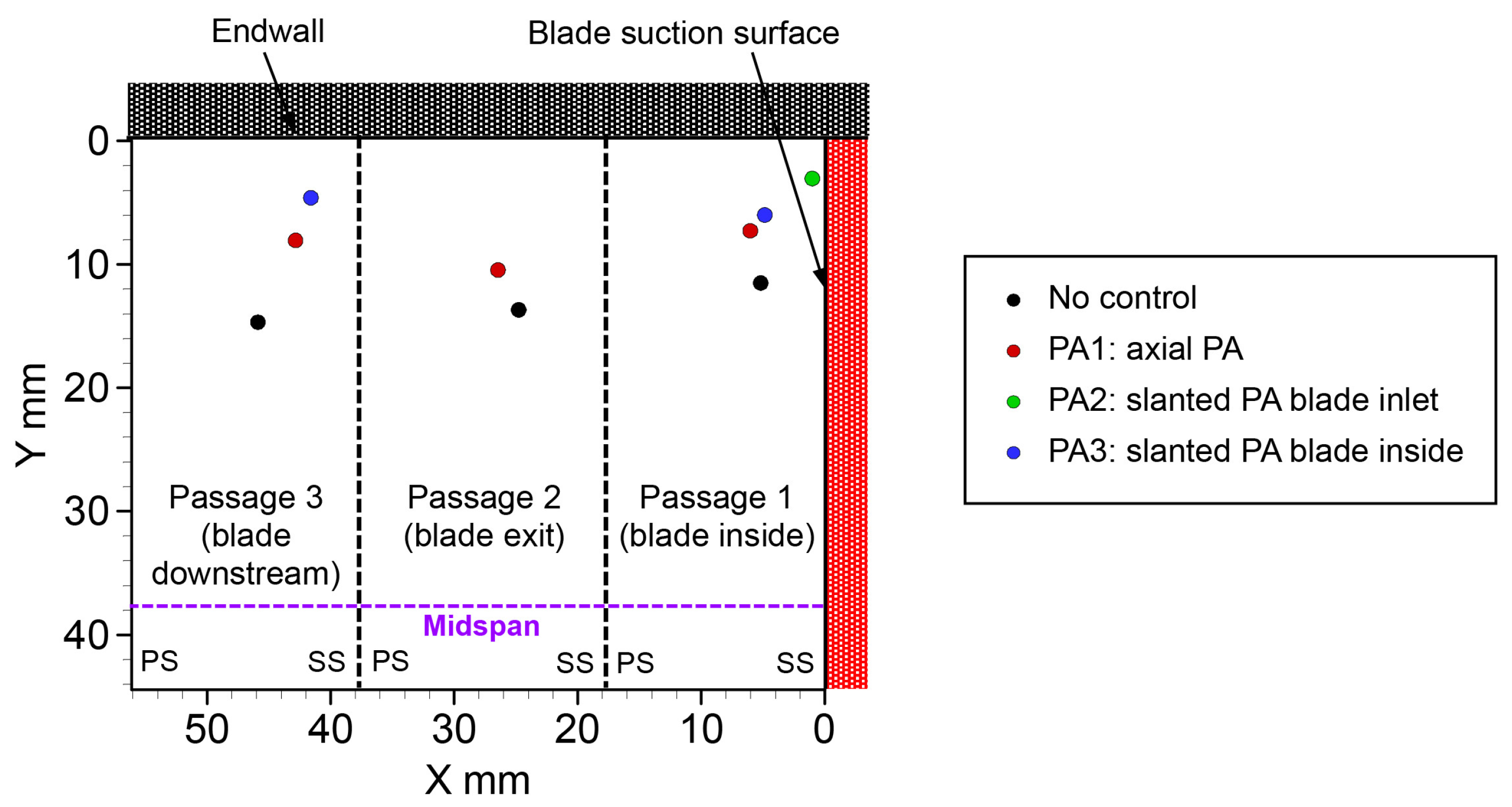
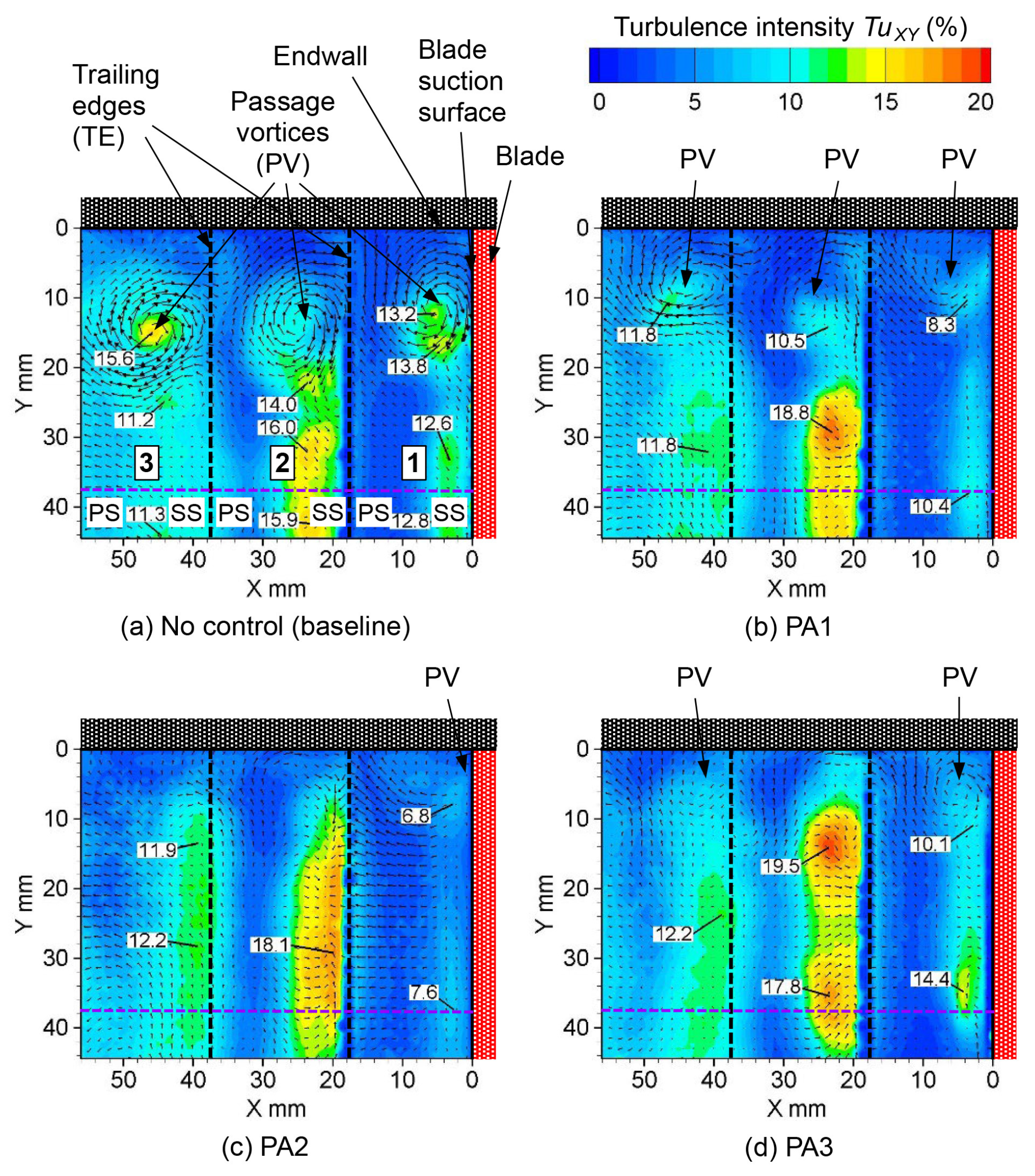
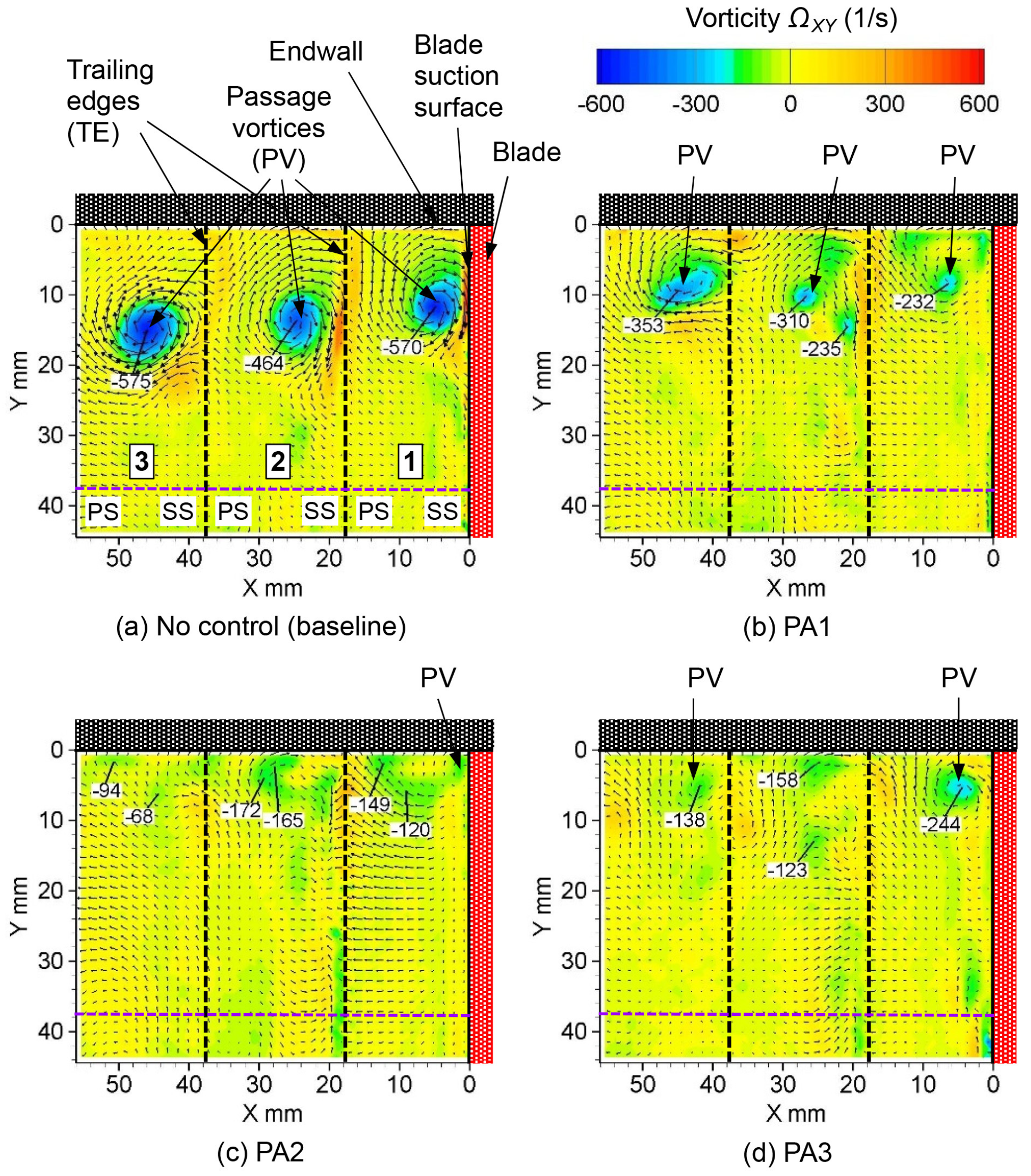
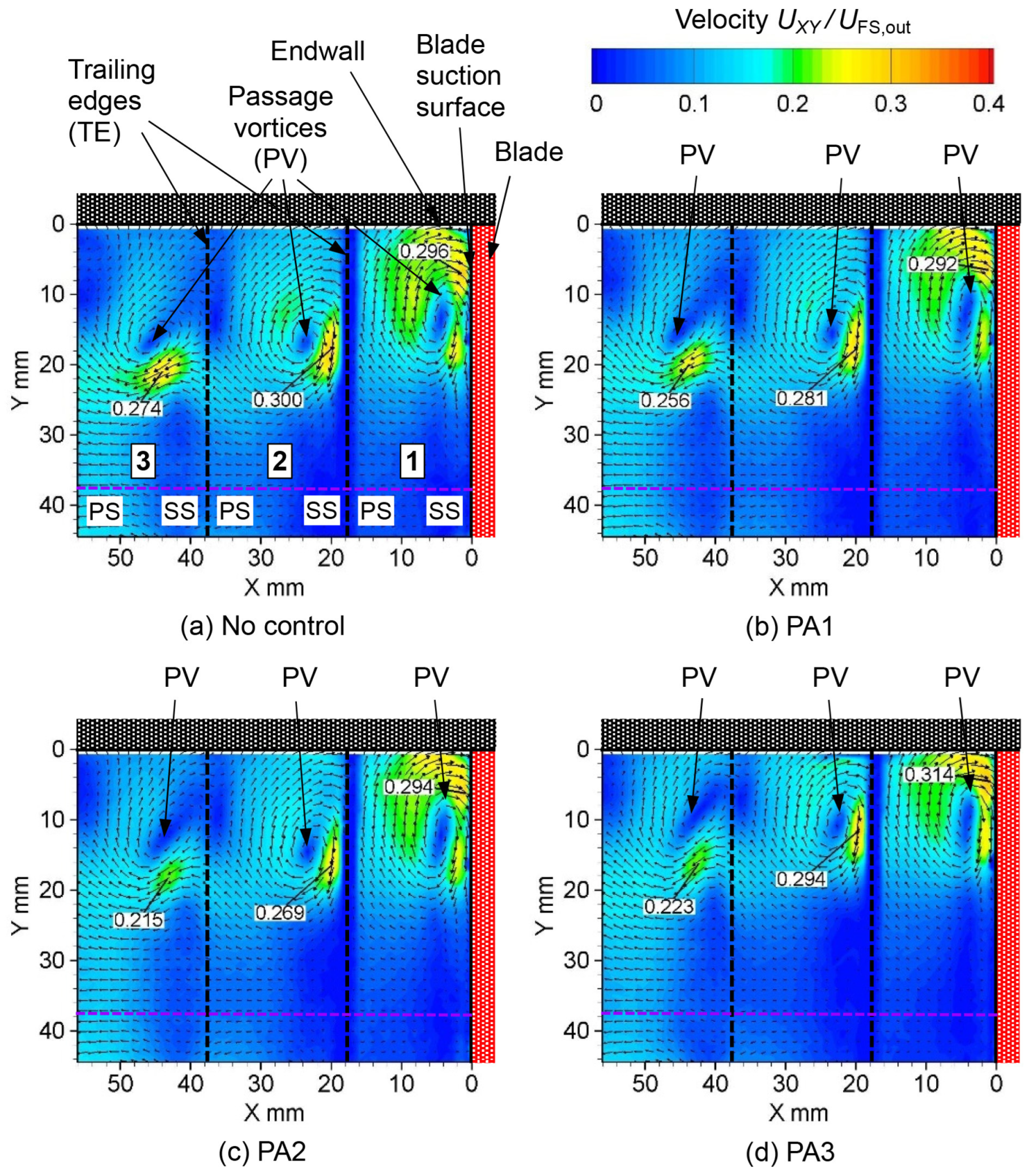




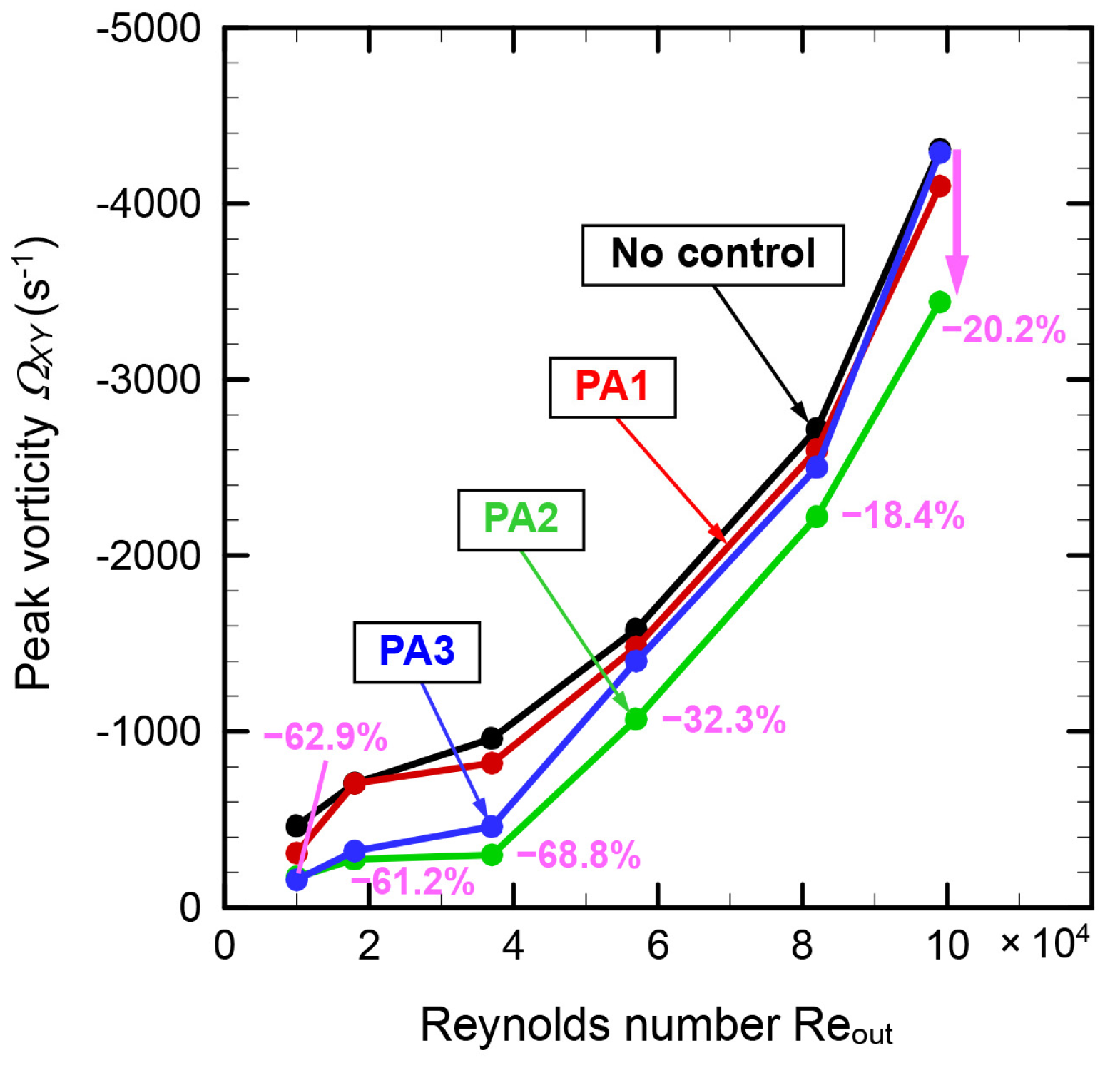
| Parameter | Value |
|---|---|
| Number of blades, N | 6 |
| Chord length, C (mm) | 58.65 |
| Axial chord length, Cax (mm) | 49.43 |
| Blade height, H (mm) | 75.00 |
| Blade pitch, S (mm) | 35.47 |
| Aspect ratio, H/C | 1.54 |
| Solidity, C/S | 1.16 |
| Inlet flow angle, α1 (°) | 51.86 |
| Exit flow angle, α2 (°) | 58.74 |
| Turning angle, α1 + α2 (°) | 110.60 |
| Stagger angle, ξ (°) | 33.43 |
| Rotating Speed of Blower (Hz) | Blade Outlet Velocity UFS,out (m/s) | Reynolds Number Reout |
|---|---|---|
| 113 | 2.4 | 1.0 × 104 |
| 225 | 4.7 | 1.8 × 104 |
| 450 | 9.4 | 3.7 × 104 |
| 675 | 14.6 | 5.7 × 104 |
| 900 | 20.9 | 8.2 × 104 |
| 1125 | 25.2 | 9.9 × 104 |
Disclaimer/Publisher’s Note: The statements, opinions and data contained in all publications are solely those of the individual author(s) and contributor(s) and not of MDPI and/or the editor(s). MDPI and/or the editor(s) disclaim responsibility for any injury to people or property resulting from any ideas, methods, instructions or products referred to in the content. |
© 2023 by the authors. Licensee MDPI, Basel, Switzerland. This article is an open access article distributed under the terms and conditions of the Creative Commons Attribution (CC BY) license (https://creativecommons.org/licenses/by/4.0/).
Share and Cite
Matsunuma, T.; Segawa, T. Effect of Plasma Actuator Layout on the Passage Vortex Reduction in a Linear Turbine Cascade for a Wide Range of Reynolds Numbers. Actuators 2023, 12, 467. https://doi.org/10.3390/act12120467
Matsunuma T, Segawa T. Effect of Plasma Actuator Layout on the Passage Vortex Reduction in a Linear Turbine Cascade for a Wide Range of Reynolds Numbers. Actuators. 2023; 12(12):467. https://doi.org/10.3390/act12120467
Chicago/Turabian StyleMatsunuma, Takayuki, and Takehiko Segawa. 2023. "Effect of Plasma Actuator Layout on the Passage Vortex Reduction in a Linear Turbine Cascade for a Wide Range of Reynolds Numbers" Actuators 12, no. 12: 467. https://doi.org/10.3390/act12120467
APA StyleMatsunuma, T., & Segawa, T. (2023). Effect of Plasma Actuator Layout on the Passage Vortex Reduction in a Linear Turbine Cascade for a Wide Range of Reynolds Numbers. Actuators, 12(12), 467. https://doi.org/10.3390/act12120467







